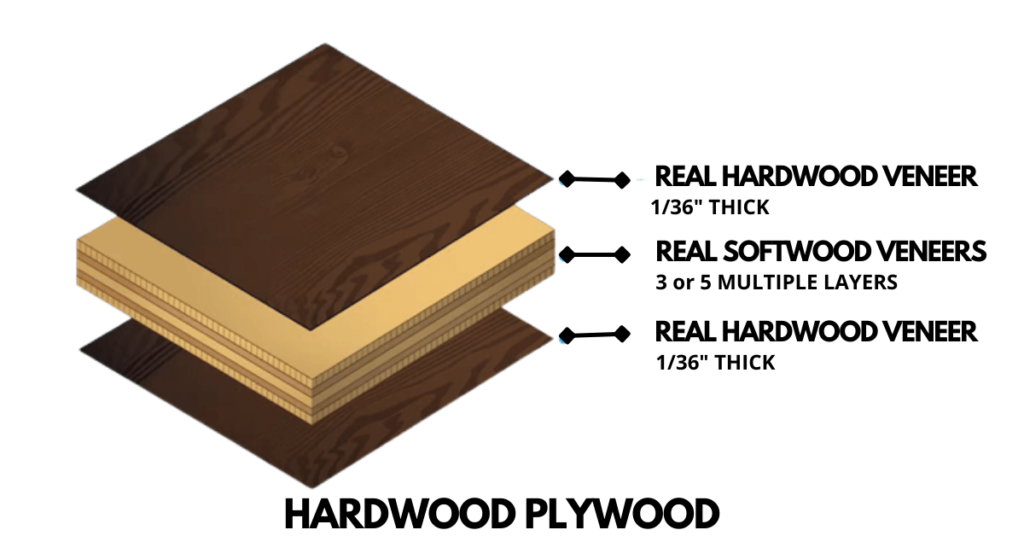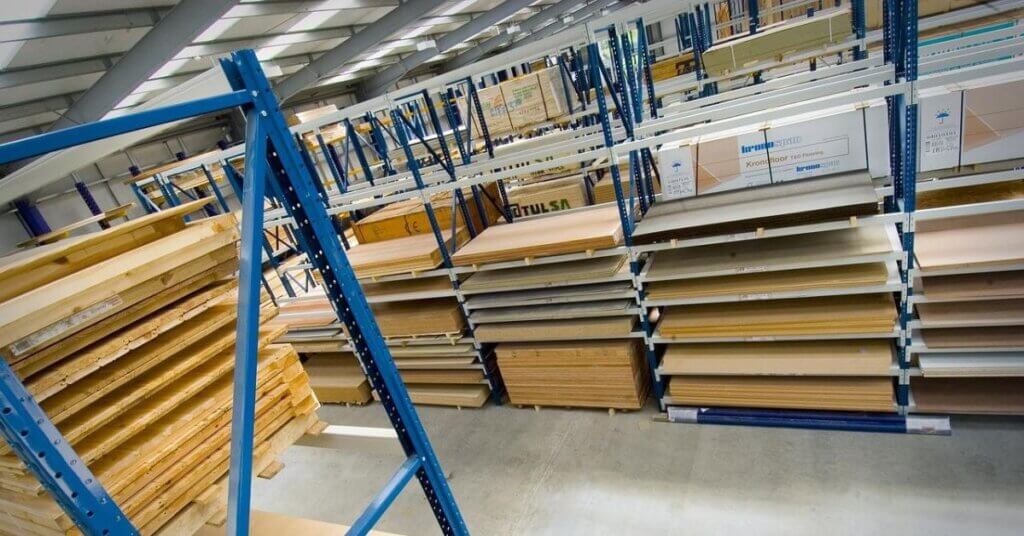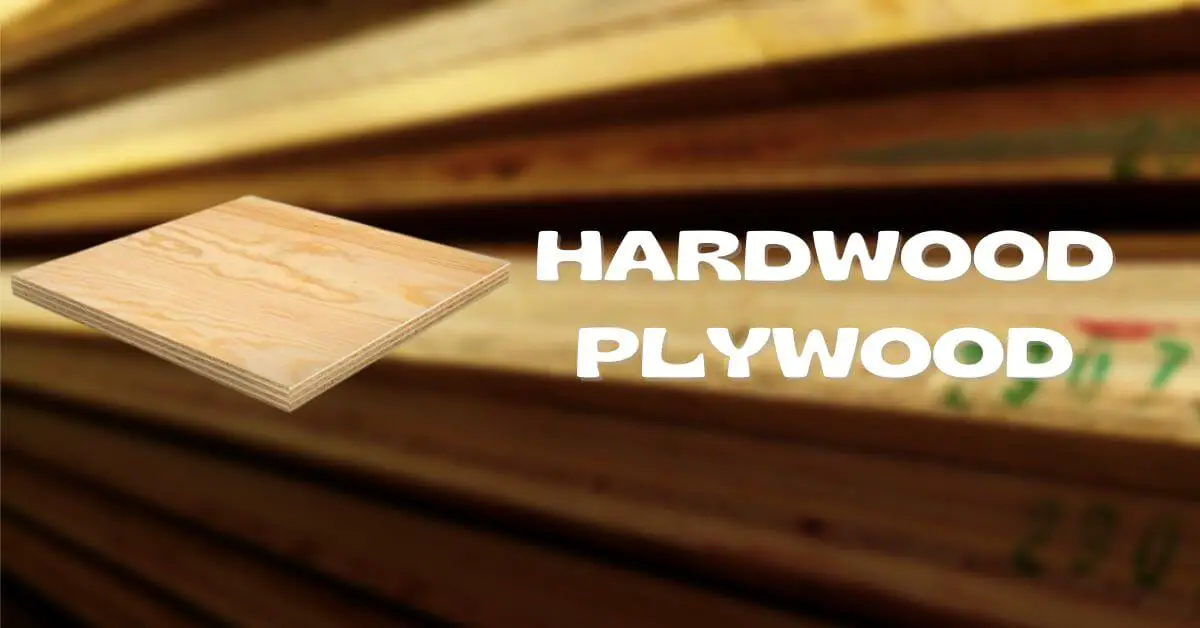What is hardwood plywood?
Hardwood Plywood is an excellent building material. The hardwood plywood is bonded with a real hardwood veneer on both sides (front and back sides) and multiple thin softwood veneers are at the core of the plywood.

Hardwood species can be maple, birch, oak, walnut, and others, while softwood can be pine, fir, spruce, cedar, and others.
All layers of hardwood plywood are glued together by Urea Formaldehyde, also known as urea-methanal or plastic resin glue. Urea Formaldehyde has excellent thermal and water-resistance properties.
Common uses of hardwood plywood
Hardwood plywood is commonly used for building furniture, cabinets, cladding, paneling, fencing, boats, outdoor decks, kitchens, skateboards, and many other projects.
Hardwood plywood is made from durable and stable veneer sheets which make it suitable for wide use. It can be used to make almost all kinds of furniture.
Hardwood plywood can be used for interior and exterior. But it is most commonly used for interior projects. Because Urea Formaldehyde is not 100% moisture and weather resistant.
Exterior grade hardwood plywood is recommended for outdoor use. It performs well in humidity and weather. Because it is made with water and weather-resistant adhesive. Exterior Grade Hardwood Plywood is only available on special orders.
Working with hardwood plywood
Working experience with hardwood plywood is very good. It is easy to work with all types of tools. If we compare it with any hardwood, hardwood plywood is easier to work with.
The density of hardwood plywood is good. So it holds nails and screws well. Hardwood plywood glues and finishes well.
There are many different types of glue available. you can use it based on your project. Urea Formaldehyde, Melamine, and Phenolic glue are mostly used for hardwood plywood.
Can you paint hardwood plywood?
Yes, Hardwood Plywood is easy to paint. It holds all types of paint well. Like wood, hardwood plywood also needs to be prepared for paint. Before moving on to the painting, you’ll need to do double coats of primer.
Primer is an essential process for painting. Plywood absorbs paint more than solid wood. Primer seals the small pores of the plywood and makes a stronger bond between paint and plywood.
The layer of paint increases the durability of the plywood. Because paint creates a protective layer between plywood and the environment.
Can you stain hardwood plywood?
Yes, you can, but it is not as easy as painting. Staining plywood is a bit more tricky than solid wood. The most common problem with staining plywood is its blotchy appearance. Because different hardwood species have different rates of absorbing stain, causing some areas to be darker than others.
Before painting, applying two coats of the Pre-stain conditioner is the best way to avoid the blotchy appearance. The pre-stain conditioner evens out the rate of absorption. So that the plywood absorbs the stain evenly.
Advantages and Disadvantages of Plywood
Advantages
1. Versatile Uses
Plywood gives you more options to use than solid wood. Hardwood plywood is a versatile product, used for a wide range of furniture and construction projects.
2. Durable and stable
Plywood is an excellent product for building furniture. It is extremely durable and more stable than many hardwoods. You can enhance the durability by exterior finishing.
3. Availability
Hardwood plywood is available in many thicknesses so that you can choose the right plywood for your jobs. We also have the option to choose from many different types of hardwood plywood such as oak, maple, birch, and many others. You can choose quality and appearance according to your job.
4. Visual appearance
The front face of hardwood plywood is quite smooth and uniform in appearance. After finishing, it looks excellent. Hardwood plywood looks like solid wood because it has natural grains that look like solid wood.
5. Water and weather resistant
Layers of hardwood plywood are glued with Urea Formaldehyde at high pressure and temperature. Urea Formaldehyde is water and weather-resistant.
Disadvantages
1. Not waterproof
Hardwood Plywood is not waterproof. It is best considered water-resistant. Exposure to water or soil causes the plywood to swell and lose the bonding of the veneer sheets.
2. Expensive
The cost of hardwood plywood is more expensive than ordinary plywood and Medium Density Fiberboard (MDF). Sometimes it can also be more expensive than solid wood of the same thickness.
3. Void and gaps
There may be gaps and voids between the veneer layers of low-quality hardwood plywood. Due to these gaps and voids, the plywood becomes weak and begins to deteriorate. But ‘A’ grade plywood has no such problems as gaps and gaps.
4. Extra finishing
The veneer sheets are visible on the edge of the plywood, which needs to be covered with a thin strip of solid wood.
5. Hard to identify
For common people (who do not know much about wood), it is difficult to identify the quality of the hardwood plywood and which wood veneer has been used for making the plywood.
Types of hardwood plywood

There are many types available in many species and grades. The most popular type is Oak, Birch, and Mahogany hardwood plywood.
Apart from this, there are many types of Alder, Ash, Beech, Bamboo, Cherry, Hickory, Maple, Poplar, Teak, Walnut, Wenge, Zebrawood, and many more.
All types of hardwood plywood have their own properties They are used on the basis of these characteristics.
Common questions about Hardwood Plywood
Is hardwood plywood expensive?
The answer is not straightforward. Hardwood plywood is more expensive than MDF, and ordinary plywood may be cheaper than marine grade plywood or solid wood.
The price of hardwood plywood depends on the quality and thickness of the plywood. ‘A’ grade plywood is the most expensive while ‘D’ grade is the cheapest.
Is hardwood plywood waterproof?
No, hardwood plywood is not waterproof. It is excellent water and weather-resistant. By the way, anything made of wood cannot be 100% waterproof. We have several methods of sealing and exterior finishing that make plywood more durable for a longer period of time.
Is hardwood plywood strong?
Hardwood plywood is stronger and more durable than softwood plywood. It can be stronger than steel and solid wood in static bending strength.
But not all grades of plywood are stronger than steel or solid wood. The strength of plywood depends on many factors, such as the species of wood used in the plywood and the thickness of the plywood.
One of the main reasons why plywood is strong is the way plywood is made. Each layer of plywood is glued on top of each other by placing them in a perpendicular direction. This structure gives strength to the plywood.
Can hardwood plywood be used for outdoor projects?
Yes, you can use hardwood plywood for outdoor purposes. But plywood needs exterior finishing. As I mentioned above, hardwood is water-resistant, not waterproof.
But hardwood plywood performs much better than normal and softwood plywood in outdoor environments.
Is Sande plywood hardwood?
Yes, Sande plywood is hardwood plywood, commonly used for interior applications such as cabinets, furniture, shelving, wall panels, tables, and other interior projects.
Sande hardwood plywood has very few voids or gaps, that is why it is durable and stable.
Sande is a species of wood most commonly used for making plywood. Apart from plywood and veneers, it is also used for paper (pulpwood).
Sande wood (Brosimum utile) is also known as Cowtree, Palo de vaca. It is native to Central America and northern South America.
Hardwood plywood density
Hardwood plywood density can range from 500 to 900 kg/m3 depending on the wood species used. Whereas pine plywood is in the range of 500 – 650 kg/m3.
Hardwood vs softwood plywood
Hardwood plywood is durable and heavier than softwood plywood. Softwood plywood is usually made from softwood, such as pine, fir, or spruce. Hardwood plywood front and back faces are made from hardwood such as Birch, Oak, or Mahogany.
But this does not mean that softwood plywoods are weak. Softwood plywoods are mostly used for interior purposes where they perform well.
Hardwood vs Sanded plywood
The front side of Sanded Plywood is smooth whereas Hardwood Plywood is rough. The most significant advantage of sanded plywood is that it does not need to be covered with laminate or paint. It already looks smooth and excellent.
The outermost layer of sanded plywood is mostly made of three or five layers of pine softwood. Sanded plywood is mostly used for cabinets, boxes, shelves, and paneling.

